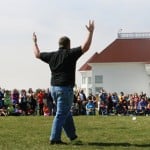Professor Raymond Shaw (Physics) and Co-PI graduate student Matthew Beals (Physics) have received $30,000 from NASA for a project, “Improved Mixed Phased Cloud Microstructure Measurements: The Holographic Detector for Clouds II (HOLODEC II).”
 The Great Lakes Innovation & Technology Report, published by CBS Detroit, reported on the research of Robert Nemiroff (Physics) into gamma ray bursts, which is giving scientists a better understanding of the makeup of the universe.
The Great Lakes Innovation & Technology Report, published by CBS Detroit, reported on the research of Robert Nemiroff (Physics) into gamma ray bursts, which is giving scientists a better understanding of the makeup of the universe.
Nemiroff’s discovery was also published in World Science and on Science Codex, an online science news site.
Spacetime: A Smoother Brew Than We Knew
Spacetime may be less like beer and more like sipping whiskey.
Or so an intergalactic photo finish would suggest.
Physicist Robert Nemiroff of Michigan Technological University reached this heady conclusion after studying the tracings of three photons of differing wavelengths that had been recorded by NASA’s Fermi Gamma-ray Space Telescope in May 2009.
Read more at Michigan Tech News, by Marcia Goodrich.
Have three little photons broken theoretical physics?
“Originally we were looking for something else, but were struck when two of the highest energy photons from this detected gamma-ray burst appeared within a single millisecond,” Nemiroff told Life’s Little Mysteries. When the physicists looked at the data more closely, they found a third gamma ray photon within a millisecond of the other two.
Read more at Science on NBC News feature “Life’s Little Mysteries.”
Something’s wrong, Einstein’s right
To detect the ripples in space-time, scientists have turned to the radiation produced by incredibly violent cosmic events, known as Gamma Ray Bursts (GRBs). Produced by the death of giant spinning stars, GRBs are bright enough to be seen billions of light-years away – far enough to allow distortions due to Planck-scale effects to reveal themselves.
Several international teams have been examining records of GRBs for signs of the effects, pushing down to ever smaller scales. The most recent results have now been announced by a group led by Prof Robert Nemiroff of Michigan Technological University.
Read more at The National, by Robert Matthews.
Quantum spacetime more like foam rubber than beer foam
A recent study of gamma-ray bursts by Professor Robert Nemiroff and his colleagues at Michigan Technological University provides the first strong evidence concerning the small-scale smoothness of spacetime. Oddly, this examination of the very small is accomplished by measuring a handful of gamma-rays after they traveled over ten billion light years.
Read more at Gizmag, by Brian Dodson.
Smooth Like Whiskey
These photons are so energetic, their wavelengths should make them small enough to interact with these little “bubbles” and be scattered. But because the photons arrived at the telescope in a dead heat, the MTU teams concludes they had nothing to interact with — that spacetime is not bubbly, but smooth (you know, like fine whiskey). Fantastic, how shall we celebrate?
Read more at Air & Space Smithsonian.
Assistant Professor Claudio Mazzoleni (Physics/EPSSI), “CAREER: Clouds, Turbulence and Mixing: A Remote Sensing Investigation within a Cloud Chamber,” NSF
Assistant Professor Kim Fook Lee (Physics), “CAREER: Fundamental Studies of Discrete Spatial EPR Entanglement,” NSF.
Assistant Research Scientist Loredana Valenzano (Physics) and Professor Ravindra Pandey (Physics), “First Principles Study of Primary Components of Portland Cement,” UCLA.
Professor and Chair Ravindra Pandey (Physics/MuSTI), “First Principles Studies of Structure-Property Relationship in Graphene-based Materials for Defense,” Army Research Laboratory.
Associate Professor Ranjit Pati (Physics), “EAGER: designing a molecular scale spin-switch,” NSF.
Physics Colloquium
Thursday, September 13, 2012
at 4:00 pm
Room 139 Fisher Hall
S. D. Mahanti
Department of Physics and Astronomy
Michigan State University, East Lansing, MI
Physics Colloquium
Sergey Kostylev
Onyx International Consulting, LLC
Detroit, MI
Thursday, September 6, 2012
at 4:00 pm
Room 139 Fisher Hall
 It’s the Great Lakes Research Center, or GLRC. The public is invited to the dedication ceremony for Michigan Technological University’s newest building, set for 2 p.m., Thursday, Aug. 2. Inside are eight laboratories, each tailored for different research topics that relate to the Great Lakes, among them exotic and invasive species, fish ecology, sediments, remote sensing and atmospheric science. READ MORE
It’s the Great Lakes Research Center, or GLRC. The public is invited to the dedication ceremony for Michigan Technological University’s newest building, set for 2 p.m., Thursday, Aug. 2. Inside are eight laboratories, each tailored for different research topics that relate to the Great Lakes, among them exotic and invasive species, fish ecology, sediments, remote sensing and atmospheric science. READ MORE
See also Atmospheric Sciences and Earth, Planetary, and Space Sciences Institute for more information about atmospheric and remote sensing activities at Michigan Tech.
 More than a dozen Michigan Tech faculty members and researchers have gone on the record in support of a ballot initiative designed to give a big boost to the state’s renewable energy industry. If passed by the voters in November, the initiative would require that 25 percent of Michigan’s electricity be generated using renewable energy sources by the year 2025. Among the signers is assistant professor of physics Claudio Mazzoleni. READ MORE
More than a dozen Michigan Tech faculty members and researchers have gone on the record in support of a ballot initiative designed to give a big boost to the state’s renewable energy industry. If passed by the voters in November, the initiative would require that 25 percent of Michigan’s electricity be generated using renewable energy sources by the year 2025. Among the signers is assistant professor of physics Claudio Mazzoleni. READ MORE
 Edward M. Leonard, Jr.
Edward M. Leonard, Jr.
Physics Alum ’12
Mind Trekkers is a group of undergraduate students from all disciplines that take STEM. “The best part about this group? It’s 100% volunteer on the student side. After finishing homework for the night, it’s Mind Trekker time. There are always more logistics to work, more lessons to plan, and more demonstrations to write, and it’s with the will power and dedication of the volunteers that we are the dynamic sensation that we are today.” READ MORE
Physics graduate student Xiaoliang Zhong and Engineering Physics graduate student Pradeep Kumar have been offered Finishing Fellowships from the Michigan Tech Graduate School. The fellowships provide support to PhD candidates who are close to completing their degrees. It is based on a student’s research, publication record, and contribution to the mission of Michigan Tech. Zhong works with Ravi Pandey in the Computational Solid State Theory and Materials Science group. Kumar is part of Miguel Levy’s research group.
 Mike Meyer has been appointed the new director for the Center for Teaching and Learning. He will start his new duties on July 9. Meyer has been at Michigan Tech since September 2002.
Mike Meyer has been appointed the new director for the Center for Teaching and Learning. He will start his new duties on July 9. Meyer has been at Michigan Tech since September 2002.
He joined the physics department as laboratory coordinator, was lecturer from 2006 to 2010, and has been senior lecturer since 2010. He was elected to Tech’s Academy of Teaching Excellenceand won the Distinguished Teaching Award in 2011.
The expanded responsibilities of the new center director are an outcome of the recommendations of the Task Force on Blended and Technology-Rich Teaching/Learning Environment and Support Systems. READ MORE